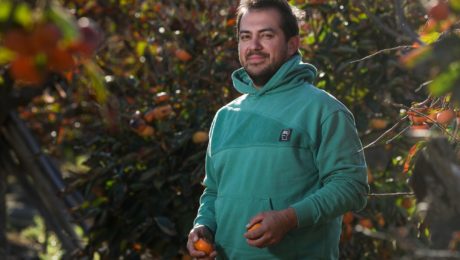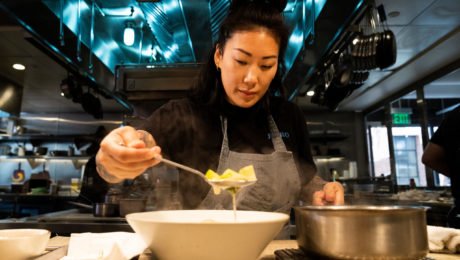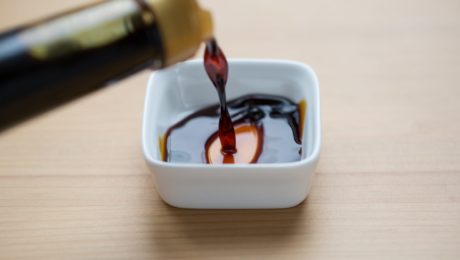San-J “Aims to Make the U.S. a Fermentation Destination”
San-J Tamari brings a unique twist in the U.S. to Asian sauces. Tamari, a byproduct of miso paste production, is a smaller subcategory of soy sauce. Tamari is made strictly from soybeans rather than the 1:1 ratio of soy and wheat used in soy sauce. And San-J’s president, Takashi Sato, envisions growing the Virginia-based brand to support the larger fermentation industry.
Sato is the 8th generation of the Sato family to lead San-J production. The Sato family founded San-Jirushi, San-J’s parent company, in Mie, Japan in 1804. They officially opened facilities in the U.S. in 1974, America’s first tamari brewing facility. Launching the brand in the U.S. in the ‘70s was an ideal time as the counterculture movement of the ‘60s was winding down. San-J was able to stand apart from major soy sauce brands because they don’t use coloring in their sauces. Chefs say the gluten-free, kosher, non-GMO standards of San-J tamari product is a big draw when looking for sauces. It’s flavor is also more intense.
“When we wanted to differentiate ourselves from Kikkoman, we noticed and focused on hippie culture in the United States since it was still active when we opened our office in 1978,” Sato says. “Taking the concept of hippie, we wanted to exclude all the additives and to make it natural.”
Sato has a bigger vision for San-J, hoping to help grow and support the fermentation industry. He wants to create a larger market through education. Sato spoke at TFA’s conference, FERMENTATION 2022. He also hosted a series of ticketed workshops last fall that included factory tours, fermented food tasting DIY miso kits and one-on-one “genius bar” sessions. He plans to host a second symposium later this year.
He’s also partnered with other fermentation scientists and educators to promote “fermentourisum” through the think tank and online platform Hakko Hub. Hakko means fermentation in Japanese.
“The demand for fermented foods isn’t strong enough in the U.S.,” Sato says. “In order to create demand, it’s important to create/stimulate interest in fermented foods.”
Read more (Richmond Magazine)
- Published in Business
Bringing Vietnamese Ferments to the U.S.
When demand in Vietnam for Song Huong Foods (SHG) fermented foods began to wane, brand owner Nguyen Le Quoc Tuan decided to take the brand overseas.
The 20-year-old ferments company is most famous for their ferments, like pickles, seafood, eggplant, sauces and pastes. But, after the pandemic, a number of Vietnamese stores selling SHG products shut down. So Tuan, knowing Vietnamese expats love to eat Vietnamese specialties, turned to U.S. exports.
After six months of food safety tests and certification from the U.S. FDA, SHG released in 32 U.S. states in December 2022, “just before the upcoming Lunar New Year,” Tuan said.
Their distributor, CTWS Group, an Asian food wholesale distributor, said it’s the first time fermented products from Vietnam are sold in the U.S.
Local production has been a challenge, so supplies are still sourced from Vietnam. Tuan’s goal is to expand in the U.S., eventually selling in Costco, then export to Japan, Taiwan, Australia, Russia and China.
Read more (VnExpress)
- Published in Business
Ugly Fruit into Delicious Kombucha
A new Los Angeles-based kombucha brand has a unique approach to their fermented tea. Sunset Cultures owner and chef Balo Orozco (pictured) uses the unsold or “ugly” fruits and vegetables from local farms into “some of L.A.’s most creative kombuchas, hot sauces and condiments.”
Staying true to his goal of curbing food waste and helping local farmers is certainly not easy. Orozco spends much of his days driving across the state to pick up boxes or pallets of produce that would otherwise be thrown away or composted. Another challenge: the kombucha flavors and condiment offerings change with the amount and type of surplus product Orozco receives from farmers. (Sunset Cultures does consistently sell four core kombucha flavors).
Orozco’s roots are in the restaurant industry. As a chef, he was alarmed at the amount of kitchen waste restaurants would throw away. His specialty soon switched to reusing kitchen scraps and fermenting house-produced condiments. After the last restaurant he worked at folded due to the pandemic, he began working on Sunset Cultures.
Sunset Cultures products are always changing and adapting based on available products. In the last six months, Sunset Cultures began making jam, a solution to their own wasted byproduct from the lightly boiled strawberries used in their kombucha.
Sunset Cultures products are currently sold in 40 retail shops and online, with plans to expand to other cities in 2023.
Read more (Los Angeles Times)
- Published in Food & Flavor
Promoting Korean Fermented Foods
Korean ferments are gaining popularity amongst U.S. consumers, and Korean agriculture leaders are trying to increase exports of Korean-made fermented foods to the U.S. At the first Korean Fermented Food Forum this month in Washington D.C., industry leaders shared their expertise on the future of Korean ferments in the American market.
“If you’re going to look at and work with fermented foods, you really have to look at Korea because that’s where all the action is, that’s where all the good food is,” says Fred Breidt, PhD, microbiologist with the USDA (and a TFA Science Advisor). Breidt was the keynote speaker at the event. “It’s becoming more and more popular to use these kinds of foods for their tremendous flavors that they can impart to food products and their health benefits as well.”
The forum was sponsored by Korea’s Ministry of Agriculture and the Korea Agro-Fisheries & Food Trade Corporation (aT Corporation). It coincided with celebrations earlier that week for November 11 being designated as Kimchi Day being in Washington D.C. and Virginia. They join New York and California, which ratified Kimchi Day in the respective states in 2021. The aT Corporation is actively leading efforts for all U.S. states to designate a Kimchi Day.
“With the growing global popularity of Korean food, I am delighted and eager to promote awareness and educate consumers on the health benefits of kimchi and Korean fermented food products, such as kimchi, fermented soybeans, salted seafood and vinegar,” says Choon Jin Kim, president of the aT Corporation. He called kimchi “Korea’s staple fermented soul food. I believe the reason that Americans enjoy kimchi so much is that the many qualities of Korean fermented foods, such as its excellent nutritional value, health benefits and taste, are beginning to shine.”
Major Growth
Sales of Korean fermented foods are growing exponentially in the U.S. According to U.S. retail sales figures tracked by The Fermentation Association and SPINS data, kimchi increased in sales by 22% in 2022, totaling $37.56 million in sales. Sales of gochujang grew 8% in 2022, totaling $6.57 million in sales.
“It’s a wave that’s been coming for a long time,” said Rob Rubba, executive chef and partner at Oyster Oyster restaurant in D.C. “Where someone who was previously omnivore like myself, who is seeking depth of flavor in something you might not associate with a vegetable, you can achieve that through fermented foods.”
When asked why fermentation grew so much during the Covid-19 pandemic, Amelia Nielson-Stowell, TFA’s editor, says fermentation touches multiple global food movements. Fermented foods are healthy, natural, green, innovative, artisanal, flavorful and functional.
“Fermentation is not a trend, it’s the oldest food craft, it’s a traditional food art with history in every culture around the world and it’s absolutely having a resurgence here in the U.S.,” Nielsen-Stowell says.
She points out that, while kimchi grew 22% in sales this year, it’s increased market size to 16% of the fermented vegetables category. In 2021, kimchi sales grew 90%, but were only 7% of the fermented vegetables category.
“More brands tuned into kimchi’s popularity, so we’re seeing more market saturation,” Nielsen-Stowell says. “There’s huge opportunities for more Korean fermented foods here in the U.S.”
Kheedim Oh attribute’s part of kimchi’s success to Korean agricultural leaders. Oh, the chief minister of New York-based brand Mama O’s Premium Kimchi, says “We have to give credit to the Korean government and groups like the aT because the Korean government recognizes the soft power of promoting.”
When he began Mama O’s 20 years ago, there were few American-made kimchi companies. Now, “there’s like a new kimchi company everyday. I don’t think it’s going to stop because kimchi is the best food ever, it goes with everything.”
Julie Sproesser agrees. Sproesser, the Interim Executive Director of Restaurant Association Metropolitan Washington, says she’s seen Korean ingredients and Korean hybrid restaurants across the D.C., Maryland and Virginia areas increase in the last seven years.
“It seems like it’s not an accident and not going anywhere,” she adds.
Today’s Science
During his presentation, Breidt shared an overview on Korean fermented foods, including kimchi, gochujang, ssamjang and doenjang.
Kimchi’s origin begins 11,000 years ago to the start of one of the world’s “first technologies invented” – pottery. Koreans discovered adding veggies with salt and water could preserve food during a time there was no refrigeration.
Scientists are continuing to learn about the significant health benefits of the probiotic-rich, lactic acid bacteria in fermented foods. Breidt says kimchi is especially beneficial because it has 10 million to 1 billion live lactic acid bacteria per gram. Through emerging genomic tools, science is now linking specific lactic acid bacteria strains in fermented foods to health benefits.
There are challenges to selling in the U.S. market, though. Briedt says many Americans like a lightly-fermented kimchi (with a pH in the high 3’s or low 4’s), but once fermentation has begun, it’s hard to stop unless it is refrigerated.
“It’s difficult to get lightly-fermented kimchi that’s imported from somewhere else. You pretty much have to get it locally or near the source of where it’s being produced,” he says, noting because kimchi is a live, fermented product, it doesn’t travel well. “The flavors will change over time, and the evolution of these microbial communities is going to proceed unless you somehow sterilize the product, which is really counter to the whole idea of what excites people about kimchi.”
The environmental factors around fermented vegetables must be meticulously monitored to produce a consistent product. Like the freshness of the ingredients, the correct size of the fermentation vessel, the cut of cabbage and the proper sterilization of cutting machines.
“Having access to high-quality products here I think is really boosting this, and it’s going to keep going as long as we continue those efforts,” Breidt adds.
The 2022 Korean Fermented Food Forum was the first, though it is expected to recur annually, coinciding with Kimchi Day. Jeanie Chang was the moderator of the forum, a licensed clinician who uses Korean dramas as a way to explore mental health through her Instagram, Noona’s Noonchi.
Chefs Turn to Fish Sauce for Flavor Punch
Fish sauce has been used for centuries as a umami “flavor bomb” for dishes. An article in British Post Magazine highlights how chefs throughout the world use regional variations of fish sauce – from Vietnamese nuoc mam, Malaysian belacan, Filipino bagoong and Italian colatura.
“Fermentation has been an integral part of many traditional food cultures to develop flavourful foodstuffs,” says Ana San Gabriel, who specializes in umami taste receptors and physiology at food and biotech company Ajinomoto.
San Gabriel details that fish sauce is made from the proteins (myosin, troponin and titin) from the flesh of fish that are broken into umami compounds (peptides and free glutamate) through salting and fermentation.
Belacan is a staple of Malaysia’s coastal cuisine. It’s a shrimp paste used in curries and sambals.
“Belacan has a deep history and heritage in Malaysia, and for many locals it evokes fond memories of family gathered together to make it from scratch,” says Jasper Chow, the executive sous chef at One&Only Desaru Coast, a luxury beachfront resort in Malaysia. “Making belacan is a delicate process that reminds us of the simple yet sophisticated methods of cooking that survive even until today.”
In Vietnam, nuoc mam is made in the southern island of Phu Quoc. It can be made from fish, shrimp or crab.
“As a dip, it highlights the sweetness and clears the greasiness of meat and deep-fried bites. It gives an exciting flavor to, yet never buries, the beautiful natural taste of fresh rolls,” says Pham Van Nhuong, the sous chef in the kitchen at Vietnam’s Tempus Fugit. “As a seasoning, unlike salt, it adds to braises, stews and even stir-fries a vigorous flavor and a signature scent.”
Bagoong in the Philippines is made from fish or krill.
“Bagoong is one of the building blocks of umami, or linamnam, in Philippine cuisine. Sometimes it’s used as a condiment or flavor for an existing dish, sometimes it will be the actual component or basic building block of a dish – like the dish binagoongan, which literally means ‘you used bagoong’,” says chef Jordy Navarra, chef at Toyo in Manila.
Colatura di alici is Italy’s modern version of garum, made from salted and fermented anchovies along Italy’s Amalfi Coast.
“We use colatura as a subtle addition to many dishes and in doing so have nearly completely removed the use of sea salt for sauces and purées,” says Antimo Maria Merone (pictured), chef at Neapolitan restaurant Estro in Hong Kong. “This allows us to precisely reach the level of sapidity by adding a certain percentage of fish sauce to the preparations that lack natural umami.”
Read more (Post Magazine)
- Published in Food & Flavor
“Koreanique” Food
As more Korean adoptees come of age to run restaurants, a new dining style is emerging: “Koreanique” (or Korean-style, Korean-inspired or “kinda Korean”).
“For these chefs, cooking is the ultimate reclamation of their Koreanness — and an act that pushes the cuisine to exciting places,” reads an article in The New York Times.
They produce dishes that “reflect their American upbringings and Korean heritage” of the adoptee chefs. Examples are: Jewish matzo ball soup with Korean mirepoix, Spam musubi burritos, kimchi-enriched carbonara, chicken marinated in kimchi brine, battered fish-sauce-laden zucchini with a sweet soy dipping sauce, jajangmyeon sauce with Bolognese and gochujang barbecue sauce.
Still, they note, feelings of imposter syndrome and cultural appropriation can take over. Adoptee chefs tell The Times they worry they’re not making Korean food authentically and they struggle with their complicated relationships with Korean food when they grew up eating a different culture’s food.
Read more (The New York Times)
- Published in Food & Flavor
The Unsung History of Umami
In the early 1900s, Japanese chemist Dr. Kikunae Ikeda discovered the flavor umami by distilling it from soup stock. That compound – which is an amino acid, glutamate — produces the savory flavor in meat, mushrooms and seaweed. Ikeda called the flavor after the Japanese word umami which means “essence of deliciousness.”
“It is the peculiar taste which we feel as umai, meaning brothy, meaty or savory, arising from fish, meat and so forth,” Ikeda wrote in the Journal of Tokyo Chemical Society.
A huge discovery, umami became the fifth flavor next to salty, sweet, sour and bitter. Ikeda went on to start a company, Ajinomoto, which mass produces monosodium glutamate — MSG — a key ingredient in producing umami.
But it took nearly 100 years for umami to be recognized by the broader scientific community, especially in the western world. An NPR story points to the anti-Asian “Chinese Restaurant Syndrome” which began in the 60s and 70s. MSG was vilified as an unhealthy additive, numbing mouths and making people sick (an apparent fable modern food scientists have never been able to prove). Another reason: umami research may have been ignored in the U.S. because of tension with Japan during World War II .
“Fermented foods and seasonings like sake, soy sauce, miso were a large part of the diet in Japan and also a large part of the economy. And so research into the flavor components of those kinds of foods were an important part of rationalizing diet in Japan.”
says Victoria Lee, professor and author of “The Arts Of The Microbial World.”
Read more (NPR)
- Published in Food & Flavor
The Complex Flavors of Soy Sauce
One of the oldest condiments in the world, soy sauce has been a staple in Asian dishes for thousands of years. The complex, umami flavor profile created by fermenting soy beans has fascinated chefs and scientists alike. Now, a new study has found over 50 flavor compounds in soy sauce.
“Decoding the flavours of this fermented food is particularly challenging because of the complex processes involved in its creation, including the microbial breakdown of compounds over time,” reads a press release by the American Chemical Society (ACS). The results of the study were published in the Journal of Agricultural and Food Chemistry.
Scientists at ACS began with the question: “Soy sauce deepens the flavor of soup stocks, gives stir-fried rice its sweet-salty glaze and makes a plate of dumplings absolutely enjoyable. But what exactly makes this complex, salty, umami sauce so tasty?”
They identified soy sauce’s flavor profile by using “tastants,” the chemical that produces a taste sensation replicating the flavor of food. This assessment identified 34 key tastants that replicated the taste of soy sauce. But the team of flavor assessors said something was not quite right “it wasn’t quite as salty or as bitter as the authentic product. The team then searched for other, unknown flavor compounds, hypothesizing that small proteins could potentially be the missing ingredient.” So scientists implemented sensoproteomics, a new method for identifying taste-active peptides in fermented foods. “…they identified a collection of proline-modified dipeptides and other larger, newly identified proteins that enhanced umami and other flavors.” The final recreated sample contained over 50 individual flavor compounds.
This analysis yielded another interesting result. Salt has long been thought to be the primary element giving soy sauce its kick. But the researchers found that saltiness wasn’t due to salt – it comes from a combination of peptides and proteins. These peptides could potentially be a healthier seasoning alternative to table salt.
Understanding the flavor profile of soy sauce could help in tailoring manufacturing processes to ensure consistent quality and boost certain flavors.
- Published in Food & Flavor
“Next Level Fermentation”
“Fermented and Flourishing” is what Whole Foods Market calls the growing world of fermented condiments. The retailer’s Trends Council released their first-ever summer condiments trends predictions.
“These days, fermented foods are an unstoppable force charging through aisle after aisle with a full head of steam. Condiments are no exception,” reads the press release. “We’re seeing tangy fermented ingredients adding flair to vinaigrettes, hot sauces, honeys and mayos. With flavor boosts like miso, kimchi and fermented garlic, these products exponentially expand the flavor possibilities of every summer soirée.”
Sales for the condiment, marinade and dressing categories are expected to hit $2.9 billion by 2024, according to market research firm Mintel.
Whole Foods’ list highlighted emerging and established fermented condiments: Lucky Foods Seoul Kimchi Mayo, Cleveland Kitchen’s line of fermented dressings and marinades, California Olive Ranch Carrot Miso Vinaigrette, Firefly Kitchens Kimchi Hot Sauce and Ninja Squirrel Coconut Sriracha Hot Sauce.
Read more (Whole Foods Market)
- Published in Business, Food & Flavor
Sriracha Shortage
A failed spring chile harvest has left sriracha brands in the lurch. Sriracha – a fermented condiment made with peppers, vinegars, salt, sugar and garlic – can’t be made without the iconic red jalapeño chiles.
Huy Fong Foods, based in Irwindale, Calif., produces one of the most popular sriracha brands. They typically use 100 million pounds of chiles a year to make sriracha, chili garlic sauce and sambal oelek. But drought in Mexico has caused an “unprecedented shortage” and left store shelves consistently empty of the famous sriracha brand.
The chile shortage is hurting other companies, too. Though Mother-in-Law’s Kimchi uses the chiles in their products, they haven’t felt the crunch so far. “It hasn’t trickled down to a smaller supplier like me yet, but I think it just means that it’s coming,” said Lauryn Chun, founder.
Read more (The New York Times)
- Published in Business










